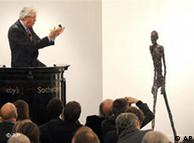Art | 16.09.2010
Commerzbank turns its art collection over to museums
Giving away a hundred valuable works of art on long-term loan may sound like something Charles Dicken's Scrooge would do after having met the Ghost of Christmas Future. However, Commerzbank's art strategy is at least as much of a win-win situation as it is a conspicuous act of generosity.
When Commerzbank absorbed Dresdner Bank in 2009, it inherited the smaller bank's formidable art collection. Instead of adding to the collection as a further investment, the hundred most valuable of its 2,000 works are being given to five museums in Germany as long-term loans - free of charge.
"We want to give something back to society," said Commerbank's CEO Martin Blessing, "That's why we've put art, culture and the young generation on our agenda. But we don't have to build up our own art collection to get involved; we believe that artworks are better off in museums."
Good time for heroics
 Bildunterschrift: Großansicht des Bildes mit der Bildunterschrift: "Evasion IV" by Franz Ackermann is on loan at Dresden's Municipal Gallery
Bildunterschrift: Großansicht des Bildes mit der Bildunterschrift: "Evasion IV" by Franz Ackermann is on loan at Dresden's Municipal Gallery
At a time when museums are scraping together funds to finance acquisitions, the offer is opportune for the five selected museums: the National Gallery in Berlin, the Museum for Modern Art in Frankfurt, the Staedel Museum in Frankfurt and Dresden's Municipal Gallery and State Art Collection. Berlin, Frankfurt and Dresden are cities to which Commerzbank has strong ties.
Curator Astrid Kiessling-Taskin, who helped build up Dresdner Bank's art collection, said it was difficult at first to digest the reality that Commerzbank was taking an entirely new approach to art. Ultimately, however, she agrees with Blessing that museums are a better place than bank offices for the art.
"Honestly, I'm somewhat relieved that these high-class works are now in good hands," she said. "We don't have the resources or the means to preserve and take care of the works so that they can be enjoyed in the coming generations."
The new course shifts the focus from the banks' prestige back to the art itself, added the curator.
Record auction price
 Bildunterschrift: Großansicht des Bildes mit der Bildunterschrift: This untitled work by Dan Flavin was loaned to Frankfurt's Museum for Modern Art
Bildunterschrift: Großansicht des Bildes mit der Bildunterschrift: This untitled work by Dan Flavin was loaned to Frankfurt's Museum for Modern Art
The Commerzbank's policy began earlier this year with the auction of the most significant piece in collection: "L'homme qui marche" by Alberto Giacometti. Unlike the other major works, it was not loaned to a museum, but purchased privately for 74 million euros (about $96 million), the highest price ever paid at an art auction.
Of that sum, one million euros in cash has been designated for each of the five chosen museums, while the rest went to Commerzbank's foundations. The extra funds are not to be used for acquisitions but for behind-the-scenes restoration and conservation work, which is less glamorous and therefore hard to find sponsors for.
"I'm very glad; now the National Gallery is a millionaire," said its director, Udo Kittelman.
Others not following suit
In shedding its art collection, Commerzbank does not seem to have started a new trend. Deutsche Bank, which owns 56,000 works on paper, has plans to continue expanding its collection, as does Allianz in Munich.
 Bildunterschrift: Großansicht des Bildes mit der Bildunterschrift: Giacometti's "L'homme qui marche" is the most expensive piece of art ever auctioned
Bildunterschrift: Großansicht des Bildes mit der Bildunterschrift: Giacometti's "L'homme qui marche" is the most expensive piece of art ever auctioned
"We're not considering getting rid of anything in our collection, except for maybe obsolete items like watercolors from the 1950's," an Allianz representative told Deutsche Welle.
Commerzbank seems to have discovered a niche with its new art strategy. It no longer has to finance the storage and restoration of the artworks - and the move is good for PR. After all, the works in the museums will be clearly identified as loans from Commerzbank.
Author: Werner Bloch (kjb)
Editor: Greg Wiser

沒有留言:
張貼留言